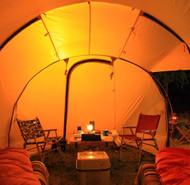Reducing Condensation In Your Tent
Posted by Kevin Muggleton on 23rd Sep 2025
Hold Your Breath, This May Come As A Shock.
Each of us exhales about 1 liter of water as we sleep at night. The water vapor we exhale is then trapped by the outermost layer of our tent resulting in the single greatest source of condensation – our breath.
It’s unavoidable. When the air temperature drops to the dew point and below, physics demands that water vapor change to liquid.
When this humid air comes into contact with cold surfaces, in this case the wall of your tent, water collects and beads - eventually dropping into your tent.
You can’t stop breathing so let’s look at ways to minimize condensation.
Ventilation is The Key to Reducing Condensation
If daytime temperatures are hot be sure to open up and vent your entire tent before heading to bed. This simple step allows the heat and humidity to escape and sets the stage for a drier night sleep. Leave a screened window or door open to allow the air you exhale to escape. Any opening will increase airflow and allow wind to enter which keeps condensation down.
The Atacama Tent Employs Mesh Screens in 4 Tent Doors
In clear weather, roll garage doors up to vent overnight, leaving the mesh in place to combat bugs. If you close the outer tent down entirely, the privacy panel of the sleep area doors can be either partially or fully zipped down depending on the temps. If conditions dictate that you shut it all down, all Redverz designs have condensation vents that are constantly in use and protected from the elements. Ideally these vents will be facing the wind for optimal flow.
Stake The Tent Out Fully, Taut
Maintaining the space and airflow between the outer flysheet and inner tent, or sleep bay, is critical to staying dry. Flysheets are designed to allow condensation to bead and run down the inside of the fly down to the ground keeping the inner tent dry. Staking the tent out properly and taut is essential to maintaining this distance and airflow. Do not allow the two layers to touch, this transfers moisture from the flysheet to the inner tent which is not waterproof in most cases.
With hoop designs like the Atacama a small gap exists between the ground and flysheet and acts as an escape for humidity and inlet for air in the garage.

Don’t Cook Inside - Boiling Water Creates Large Vapor Volumes
From safety to extra condensation, there are many reasons not to cook in your tent. It’s tempting, especially in an Atacama or Solo with large utility bays but the costs outweigh the benefits.
Wet Clothes and Gear Bring Added Moisture Into the Tent
Leave the wet stuff outside to dry whenever possible. If it must come inside consider storing it in a dry bag to prevent evaporation.
Location Location Location - It counts for Camp Sites Too
Ground moisture rises from lush, green grass, especially after a good rain. It looks inviting but produces humidity at a level on par with a sauna by the end of the day. Redverz designs custom-fit ground sheets for just this reason. Use the garage area ground sheet to keep moisture down in the more susceptible, single-walled area of your tent. The sleep area is further protected with a custom sheet and is double walled for added protection.
Low-lying valleys tend to collect cool air and have far more ground moisture because airflow is diminished. When possible, choose higher points with warmer temperatures and a bit better airflow. Always consider the severity of the wind and choose accordingly.
If You Can’t Beat It, Wipe It Down
Carry a microfiber or pack towel to wipe away excess moisture.
Is It Condensation or a Proper Leak? Here’s How To Tell For Sure
Identify the source location of the moisture. Set the tent up in your back yard. Run the garden hose over the exact spot and see if water comes through. 999 times out of 1000 condensation will be the culprit. If not, a bit of maintenance and a dab of seam sealant on the affected area will do the trick.
Even a clear, dry night can leave a seasoned camper with moisture beads clinging to tent walls the next morning. Don’t be discouraged, use the tools available to you and keep dry.
Have some other ways to reduce condensation? Let us know

